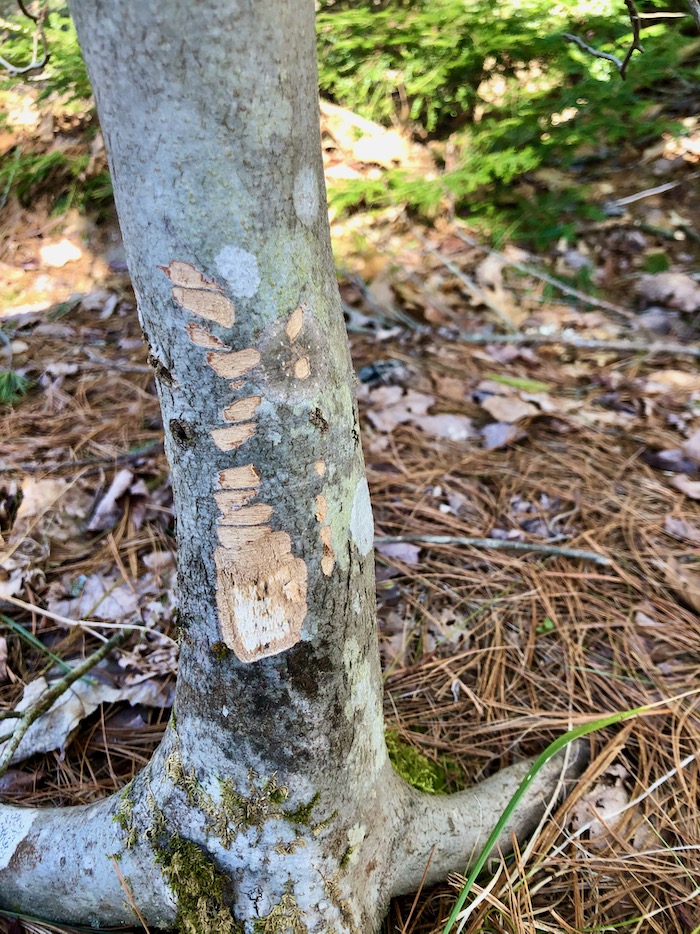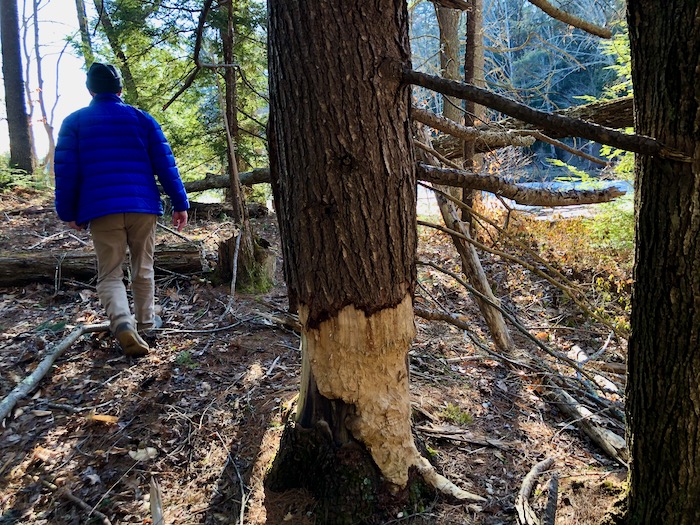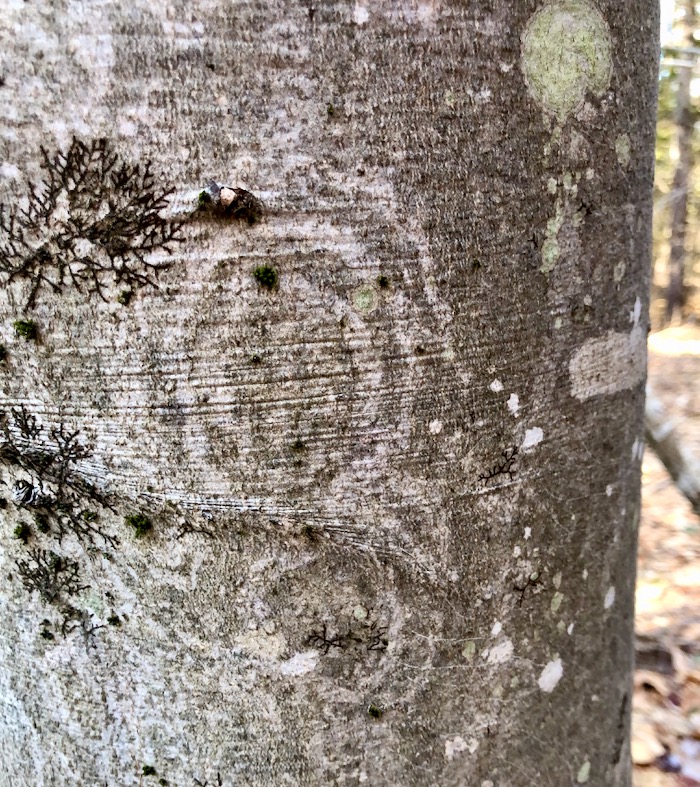Today’s blog is a break from the horse talk. Sort of.
Steve and I hired a Registered Maine Guide to walk us through our backyard. We’ve owned our 11-acres in southern Maine for a year now. We look at, walk through it, and appreciate it, every day. But that doesn’t mean that we see it.
On a beautiful late winter afternoon, Dan Gardoqui took us for a three-hour hike in our woods. We checked out what the beaver are up to. Sometimes they try a sapling and decide not to finish the meal. Before the hike with Dan, I would have recognized this as beaver sign. But what I didn’t know was that the scrapes on the right are the upper incisors, the ones on the left the bottom teeth. With that information, you can imagine the big brown rodent, sitting on its butt, with its head tilted, peeling the bark off of the tree with its long yellow teeth.

I’ve also seen very large trees with their bark girded off. The trees seemed too big to be ones that the beavers were harvesting for food. Dan explained that sometimes the beaver decide that a tree should die. They simply don’t like it standing in their way. Not good for the tree, but very good for the forest ecosystem, as dead trees are home and food for many other creatures.

We learned to recognize the paths the beavers use to go to and fro the wetlands, and all sorts of other clues that tell us what these animals are doing. We also looked for the best places to spot river otter.
We checked out some of our neighbors’ homes. A porcupine likes to den here. They don’t need deep caves or bedding. Another porcupine lives in the hollow of a tree. We saw scat and quills at the base of that shelter.

Lots of small critters live in tree cavities. If you look closely at the chewed up nuts that they toss out, you can tell who is in residence.

The forest housing market is frequently changing. A pileated woodpecker is making room for a new family. It’s not ready yet.

We learned how to distinguish between deer browse on sapling and other marks that indicate antler rubs. Before this walk, they all looked the same to me.
We looked at a pile of feathers, and looked up to see where the owl had consumed its kill. We learned how to look at feathers to tell if the predator was a mammal or a raptor.
Dan was excited to see this right on a trail. A bobcat scratching post.

Perhaps my favorite find of the day was something far more subtle. It’s something I’ve enjoyed looking at, but somehow never questioned. Have you ever seen beautiful swirl patterns on bark?

These are made by slugs eating the algae on the surface of the tree! How amazing is that?
Loving something is fine and good. But close observation, combined with knowledge and science, gives you a depth of appreciation that is very gratifying. Learning more about our property will allow us to be better stewards, and also, simply, to make our time here more filled with wonder.
Many of my blogs about horses return again and again to starting from a base of observation, then learning about what it is that we’re seeing, and then applying that to our horsemanship. Not a bad way to see the world, too.
What small thing have you seen for ages, but finally recently learned about? Tell me in the comments!


What a great way to learn more about your neighbours and environment. Indeed we are family and this will add quality and pleasure in knowing what is going on on their level. So much is going on and so very few are aware ! Thanks for sharing this great day of learning with us. Looking forward to more throughout the new season ! Happy Spring !
We need Dan to come back when the summer birds arrive. Already the verges between woods and field are filled with song.
Migration may already have begun in your region ! how exciting ! There must also be an ornithology club nearby and surely a trusty field guide that will help you identify them and their song(s) … it really is a fascinating kingdom of Blueberry ✨✨✨
Lovely post and a very good reminder of the world all around us. You have inspired me to seek out nature talks around me. Thank you.
Wonderful! Our local library sometimes has interesting talks, as do the local nature preserves. Let me know what you hear.
What an amazing backyard and so much wildlife, you must be so pleased that you found your perfect home. Have fun. Still read all your blogs, love following your onward story. Thanks for sharing, 🙂
Hello Terry, I have been enjoying your blog since your “Gems” and my group of new chicks started off at almost the same time. Such a help – I am sure my girls had a better life because of your close observation. I have just lost the last of those old girls – a lovely character that leaves a large gap.
However, my most recent observation is simpler: did you know artichoke seedlings want to send down a deep taproot right away, before they even make their second set of leaves? I have just found roots peaking out of a series of pots that had just barely sprouted, and rushed to get the babies into larger pots and/or their final spot. Did not pay attention to this last time I grew them and the results were haphazard. It will be interesting to see if this makes a difference. I also dug the ground much deeper this time. We shall see! Thank you again for all your sharing.
I’ve never grown artichokes. How interesting! What a life your old girl had! Those old characters are sorely missed.
Yes indeed. It was also interesting that this last hen that lived the longest and developed the most powerful personality was the runt of the group and nearly died as a chick after eating a paper towel!
What a clever thing to have done. I wouldn’t have thought of it!
Steve took a morning tracking class taught by Dan that was offered by a local conservation group. Steve wanted to bring Dan’s insights and knowledge to our backyard. Well worth the time and money!
We have a mushroom here in the desert called the “Shaggy Mane,” that I’d seen for quite some time before even realizing it was a mushroom. https://www.kcet.org/redefine/hard-summer-rains-bring-desert-mushrooms I had spent the first 40-odd years of my life back east, and had seen those swirls on trees, but hadn’t known they were from slugs. Thanks for that, that’s really neat!
That is an interesting mushroom!
Not at all outdoorsy, I am just now beginning to enjoy not only the plot but the overall appearance of books: choices made about fonts, paper, binding etc.
I agree! I’m a published author and have been privileged to work with some talented designers at major publishing houses. There are many hands that go into those decisions. The copyright page of the book often lists the names of some of the designers. Sometimes the author thanks them in the acks. Some have a recognizable signature style that you can learn to recognize.